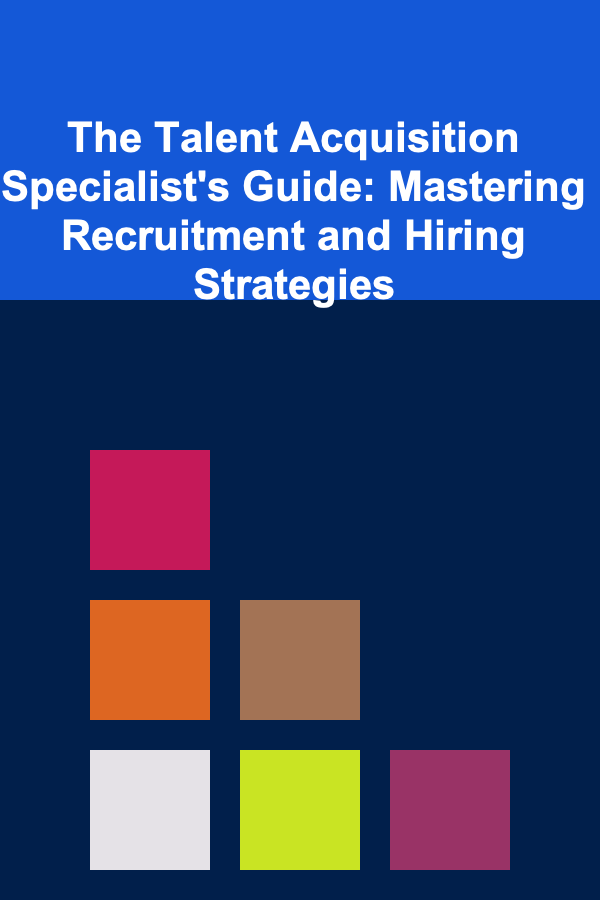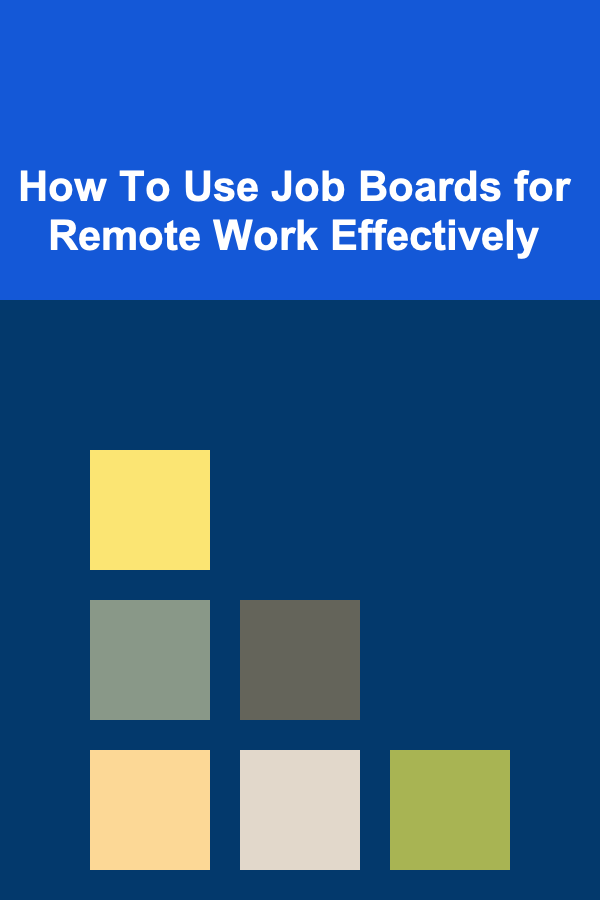
The Talent Acquisition Specialist's Guide: Mastering Recruitment and Hiring Strategies
ebook include PDF & Audio bundle (Micro Guide)
$12.99$5.99
Limited Time Offer! Order within the next:

In today's competitive job market, talent acquisition is more crucial than ever. A strong recruitment process not only helps you secure the best candidates but also shapes your company's culture and long-term success. Talent Acquisition Specialists (TAS) play a pivotal role in identifying, attracting, and hiring top-tier talent, ensuring that the right candidates are selected for the right roles at the right time.
This guide will walk you through the essential recruitment and hiring strategies that every Talent Acquisition Specialist should master. By the end, you'll be equipped with practical tools, insights, and strategies to enhance your hiring process and ensure that you consistently attract high-quality talent.
Understand the Business Needs and Company Culture
Before starting the recruitment process, a Talent Acquisition Specialist must understand the broader context of the hiring requirements. Every successful recruitment strategy begins with a deep understanding of the company's goals, culture, and the role in question.
Aligning Recruitment with Business Strategy
- Collaborate with Hiring Managers: Close collaboration with department heads or hiring managers is essential to gaining a clear understanding of the role. Discuss not only the technical skills required but also the soft skills that will complement the team's dynamics.
- Understand Long-Term Goals: Gain insight into the company's long-term objectives. Are they focusing on expanding internationally, launching new products, or diversifying their workforce? Knowing these things will allow you to hire with foresight, considering not just the current needs but the evolving demands of the business.
- Map Skills to Business Needs: Consider the broader skills your business needs over time. For example, if your company plans to shift its operations to a digital-first model, you might need candidates with specific technical expertise to facilitate this transformation.
Defining Company Culture and Values
Culture fit is just as important as skills. The success of any recruitment process depends on finding individuals who align with your organization's culture, vision, and values. Define your company's culture and use it as a benchmark for evaluating candidates.
- Promote Core Values in Job Descriptions: Ensure that the company's values are reflected in job postings and recruitment materials. This helps attract candidates who resonate with the organization's mission.
- Assess Cultural Fit During Interviews: Evaluate how well candidates' values align with the company culture. Are they likely to work well with the team? Will they adapt to the working environment? Ask behavioral interview questions that can help uncover these attributes.
Develop an Effective Recruitment Strategy
A good recruitment strategy is critical for attracting top talent and streamlining the hiring process. This requires planning, creativity, and flexibility to adapt to changing market conditions and business needs.
Build an Employer Brand
An employer brand is the perception that potential candidates have about your organization. It can significantly influence their decision to apply for a job and, in turn, impact the quality of applicants you receive.
- Leverage Social Media: Social platforms like LinkedIn, Glassdoor, and Twitter are excellent tools for showcasing your company's culture, values, and achievements. Share employee success stories, workplace events, and company initiatives.
- Promote Employee Testimonials: Encourage current employees to share their positive experiences, either through blog posts, videos, or social media. Peer testimonials create authenticity and trust with candidates.
- Ensure a Positive Candidate Experience: From the first point of contact to the final interview, ensure that candidates have a positive experience. A smooth, respectful process shows the company's professionalism and values its applicants.
Utilize Diverse Sourcing Channels
Talent acquisition today is about using the right mix of traditional and innovative sourcing channels. By diversifying your recruitment efforts, you increase your chances of reaching high-quality candidates.
- Job Boards and Career Websites: Platforms like Indeed, Glassdoor, and Monster are still important for posting open roles and finding a wide range of candidates.
- Social Media Recruiting: Leverage social media networks such as LinkedIn, Twitter, and Facebook to find passive candidates---those not actively looking for a job but open to new opportunities.
- Employee Referrals: Employees are often the best source of talent. Offer referral bonuses or incentives for employees who refer successful hires. Employees usually understand the company culture and are likely to recommend candidates who fit well.
- Talent Pools and Networking: Build and maintain a talent pool---a database of potential candidates for future job openings. Attend industry conferences, webinars, and networking events to meet potential candidates before a position even opens up.
Leverage Recruitment Technology
Recruitment technology has revolutionized how Talent Acquisition Specialists source, engage, and evaluate candidates. Tools like Applicant Tracking Systems (ATS), Artificial Intelligence (AI), and chatbots can streamline and optimize the process.
- Applicant Tracking Systems (ATS): An ATS helps organize resumes, track applications, and manage communication with candidates. It ensures that you don't miss out on top applicants and can quickly search for candidates who meet specific criteria.
- AI Screening Tools: AI can be used to filter out resumes and rank candidates based on predetermined qualifications. These tools can save time by automating the initial stages of recruitment.
- Video Interview Platforms: Platforms like Zoom, HireVue, or Spark Hire are essential in remote hiring, making it easier to conduct interviews and evaluate candidates from anywhere in the world.
Screening and Interviewing Candidates
Effective screening and interviewing are critical to selecting the best candidates. It's important to move beyond just assessing qualifications and experience; you should also evaluate soft skills, cultural fit, and the potential for long-term success.
Resume Screening and Candidate Shortlisting
Screening resumes is the first step in evaluating potential candidates. While ATS can help automate this, it's still crucial to manually assess the fit.
- Match Skills and Experience: Look for candidates who meet the technical qualifications for the role. However, don't just focus on keywords. Look for specific achievements and relevant experience that align with the role's needs.
- Assess Career Trajectory: A candidate's career progression can tell you a lot about their ambition, work ethic, and skill development. Look for candidates who have shown continuous growth.
- Check for Red Flags: Red flags may include job-hopping, lack of career progression, or unexplained gaps in employment. While these aren't necessarily deal-breakers, they should be further explored during interviews.
Conducting Effective Interviews
The interview is where you assess whether a candidate has the right skills and qualities to excel in the role. It's also where you make a final judgment about their potential to fit within the company culture.
- Use Structured Interviews: Standardize your interview process to ensure that all candidates are assessed based on the same criteria. Use the same set of questions for every interview to make it easier to compare candidates.
- Behavioral Interview Questions: Ask about past situations to gauge how candidates have handled challenges in their previous roles. For instance, "Tell me about a time when you had to meet a tight deadline. How did you manage?"
- Assess Soft Skills: In addition to technical expertise, assess candidates' interpersonal skills, problem-solving abilities, and communication styles. These qualities often determine whether a candidate will thrive in a role.
- Technical Assessments: For specialized roles, consider including a technical assessment or a practical test to evaluate how candidates handle real-world tasks and challenges.
Making the Offer and Onboarding
The hiring process doesn't end with the interview---it's essential to smoothly transition from candidate selection to offer extension and, eventually, onboarding.
Extending the Offer
Once you've selected the best candidate, the next step is to extend a formal job offer. This can be done over the phone initially, followed by a written offer.
- Offer Negotiation: Be prepared for negotiation. Candidates may want to discuss salary, benefits, and other terms of employment. Understand the company's limits and approach these discussions with flexibility and transparency.
- Communicate Company Benefits: Ensure that the candidate understands not just the salary, but also the company's benefits package---healthcare, paid time off, retirement plans, etc.
Onboarding Process
The onboarding process is crucial for setting up new employees for success. It should be designed to help them understand their role, integrate into the team, and become productive as quickly as possible.
- Provide Clear Documentation: Ensure that new hires have all the necessary information about company policies, processes, and benefits before they start.
- Assign a Mentor or Buddy: Pair new hires with a mentor who can guide them during their first few weeks. This helps with socialization and ensures they understand their role in the team.
- Conduct Regular Check-ins: Even after the new hire starts, regular check-ins with HR and team leaders can ensure they feel supported and on track.
Evaluating and Improving the Recruitment Process
Talent acquisition is an iterative process. Continuously evaluating and refining your recruitment strategy can help you stay ahead of the competition and improve the quality of your hires.
- Track Key Metrics: Measure success by tracking key performance indicators (KPIs) such as time-to-fill, cost-per-hire, and candidate quality. This will help you identify areas for improvement.
- Solicit Feedback from Candidates: Ask candidates for feedback on their experience during the recruitment process, regardless of whether they were hired. Their insights can highlight areas where you can improve.
- Refine Your Strategy: Based on the data you collect, make adjustments to your sourcing, screening, and interviewing strategies. Recruitment is dynamic, and the best approaches will evolve as your company grows.
Conclusion
Mastering recruitment and hiring strategies is a continuous journey for any Talent Acquisition Specialist. By aligning your recruitment efforts with the business's long-term goals, implementing effective sourcing and interviewing techniques, and ensuring a seamless candidate experience, you can consistently bring in top talent that drives success. Furthermore, always evaluate and refine your strategies to stay agile and responsive to the changing needs of the business and the job market.
Talent acquisition is not just about filling positions; it's about building a team that can elevate your organization's performance, culture, and future. With the right strategies in place, you'll be well on your way to becoming an invaluable contributor to your organization's success.

How to Maintain Your Home's Septic System to Prevent Problems
Read More
How to Save Money on Lighting by Using Dimmers and Timers
Read More
How to Use a Binder Clip System for Paper Management
Read More
How To Use Job Boards for Remote Work Effectively
Read More
How To Understand Threat Intelligence for Beginners
Read More
How to Understand the Impact of Coffee on the Environment
Read MoreOther Products

How to Maintain Your Home's Septic System to Prevent Problems
Read More
How to Save Money on Lighting by Using Dimmers and Timers
Read More
How to Use a Binder Clip System for Paper Management
Read More
How To Use Job Boards for Remote Work Effectively
Read More
How To Understand Threat Intelligence for Beginners
Read More